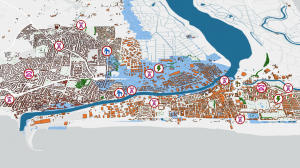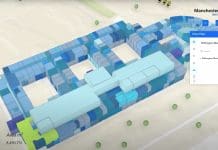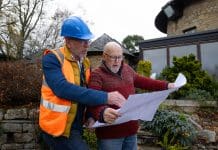At COP26, the National Digital Twin launched the Climate Resilience Demonstrator (CReDo) project with a short film, Tomorrow Today, highlighting the essential role of infrastructure in the climate emergency along with an interactive app to explore how connected digital twins can help plan for better adaptation and resilience
One of the key take-aways from the COP26 climate conference is that to avert climate disaster collaboration is essential. We need cities, regions, governments and businesses all working together to accelerate progress.
The National Digital Twin’s Climate Resilience Demonstrator (CReDo), launched during COP26, provides a clear example of this kind of collaboration in practice and showcases the dramatic impact that sharing information across organisations can have in improving climate resilience.

Why is CReDo relevant?
CReDo is a pioneering project to develop, for the first time in the UK, a digital twin across key services networks to provide a practical example of how connected data and greater access to the right information can improve climate adaptation and resilience. It looks specifically at the impact of extreme weather, in particular flooding, on energy, water and telecoms networks. It demonstrates how those who own and operate them can use secure, resilient information sharing, across sector boundaries, to mitigate the effect of flooding on network performance and service delivery to customers.
Collaborating on CReDo are Anglian Water, BT and UK Power Networks, who will use their asset and operations data as well as weather data on a secure, shared basis to inform an increased level of infrastructure resilience.
The project is being delivered through a collaboration of research centres and industry partners; the universities of Cambridge, Edinburgh, Exeter and Warwick are working alongside the Science & Technology Facilities Council, CMCL Innovations and the Joint Centre of Excellence in Environmental Intelligence. It is funded by UK Research & Innovation (UKRI), the University of Cambridge and Connected Places Catapult.
It shows that collaboration across a team that spans industry, academia and government forms an essential piece of the puzzle that unlocks climate adaptation solutions and to reaching net zero. It also provides a tangible proof of concept that interconnected digital twins work and there is the right technology and information management framework to underpin them.
What is needed to progress further is an increased willingness to share the data. There are understandably still concerns over data security, but this is an area being addressed by CReDo. A huge amount of work is being put into establishing the framework to cover technical, legal, procedural and security concerns and applying federated access protocols. We hope this will pave the way for a culture shift in viewing the sharing of data as an integral part of the way we work.
Impacting lives
The victims of climate-related natural disasters are not always those who have lost their homes or lives directly but include those who are impacted by the cascading failures of services such as medical care, clean water or power.
Alongside the launch of CReDo, the National Digital Twin programme (NDTp) also premiered the film Tomorrow Today – a poignant piece about the climate emergency and how it affects us all, especially the most vulnerable. The film is based on a fictional storm, Ruby, caused by climate change and presents a realistic scenario that we could be faced with. It also provides a solution: a world where engineers can make critical decisions based on data from connected digital twins and improve resilience in a way that makes a difference to people’s lives.
The CReDo app, produced by ESRI UK, is also based on storm Ruby in the fictional town of Sunford City. It provides an interactive way for users to see how connected digital twins can change outcomes for those faced with extreme weather. The app was developed with manufactured data to again present a realistic scenario that asset owners could face. The user is invited to make decisions to maximise the resilience of Sunford City and in doing so see how having greater visibility across the entire infrastructure system, rather than one individual network, can enable better decision making and achieve greater levels of resilience.
A scalable approach
The intention is that CReDo will be scalable to other networks, contexts and locations.
Using the information management framework approach, CReDo will demonstrate how digital twins and datasets can be connected at scale as we move towards a future where more organisations across government, industry and academia will be sharing data across organisational and sectoral boundaries to enable better outcomes for people and the environment.
CReDo provides an important step forward in the journey towards a National Digital Twin and a working demonstration of the technology and collaboration that underpins it.
Digital Twin Hub
https://twitter.com/DigitalTwinHub
https://www.linkedin.com/company/digital-twin-hub/
https://www.youtube.com/playlist?list=PLdoIegAvVBQMUzCT3d1m6iqGsb6Kryzjl













